Best Practices for Dealing with Tenants
Key Learning Objectives:
Introduction: Building robust and trustworthy relationships with tenants can significantly amplify the success rate of a real estate investment. In this chapter, learn the crucial strategies for forging these relationships, averting potential setbacks, and ensuring a harmonious landlord-tenant coexistence.
- Understand the value of meticulous tenant screening to predict and prevent potential issues.
- Recognize the need for transparent lease agreements that elucidate the rights and responsibilities of both parties, offering a reference for conflict resolution.
- Grasp the essence of effective communication in nurturing a pleasant rapport with tenants, preventing misunderstandings, and fostering community spirit.
- Learn the importance of property inspections and timely maintenance in upholding property value and tenant satisfaction.
- Develop strategies to address tenant issues with empathy and legal awareness to ensure both parties’ satisfaction.
- Familiarize yourself with the correct legal procedures and documentation for evictions and the end of tenancy.
Effectively managing tenant relationships is essential for a successful real estate investment. In this chapter, we will discuss best practices for dealing with tenants, reducing the chances of losses and bad interactions, and identifying potential concerns. By following these guidelines, you can create a positive and profitable environment for both you and your tenants.
A. Tenant Screening and Selection
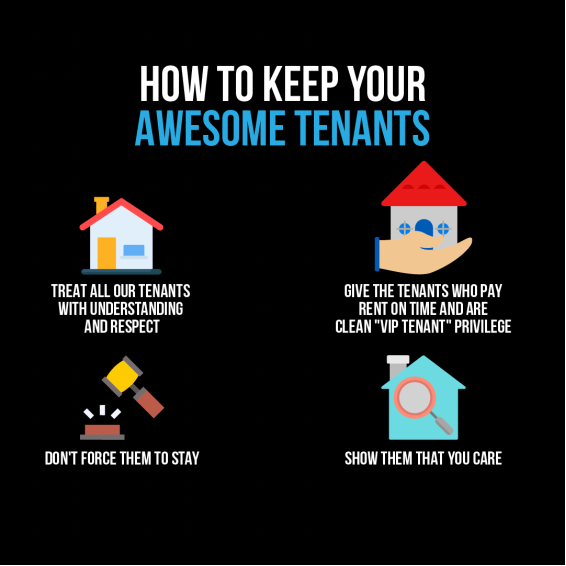
Figure: This infographic provides valuable advice on “How to Keep Your Awesome Tenants.” It emphasizes the importance of treating all tenants with understanding and respect, offering privileges to those who pay rent on time and maintain cleanliness. The infographic also suggests not forcing tenants to stay against their will and showing genuine care for their well-being. These tips are crucial for landlords and property managers, highlighting effective strategies to maintain positive relationships with tenants and ensure a stable and respectful rental environment.
Source: Custom Infographic
- Conduct thorough background checks: Verify the tenant’s identity, credit history, employment, and rental history to ensure they are reliable and financially stable.
- Check for past evictions: Investigate if the prospective tenant has been evicted previously, as this could indicate potential issues in the future.
- Contact references: Speak with previous landlords and employers to gather additional information about the tenant’s reliability and behavior.
- Establish clear rental criteria: Set specific standards for income, credit scores, and other factors to maintain consistency and avoid potential discrimination claims.
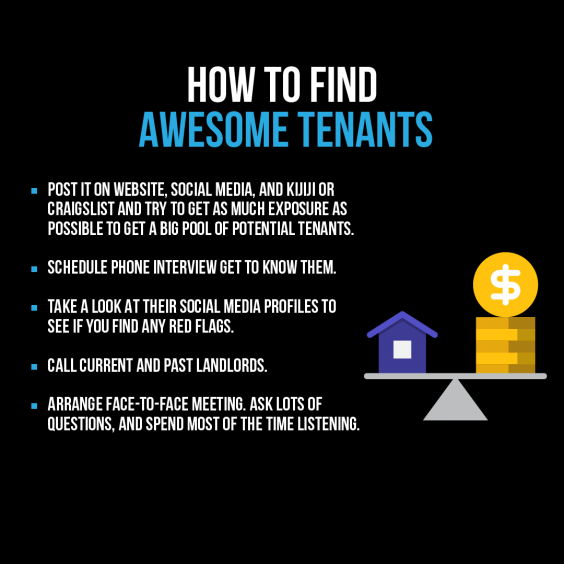
Figure: This infographic offers practical guidance on “How to Find Awesome Tenants.” It suggests maximizing exposure by posting rental listings on websites, social media, and platforms like Craigslist. The steps include scheduling phone interviews to understand potential tenants, checking their social media profiles for red flags, contacting current and past landlords for references, and arranging face-to-face meetings to ask questions and listen to the applicants. This approach is essential for landlords and property managers to ensure they select reliable and suitable tenants for their properties.
Source: Custom Infographic
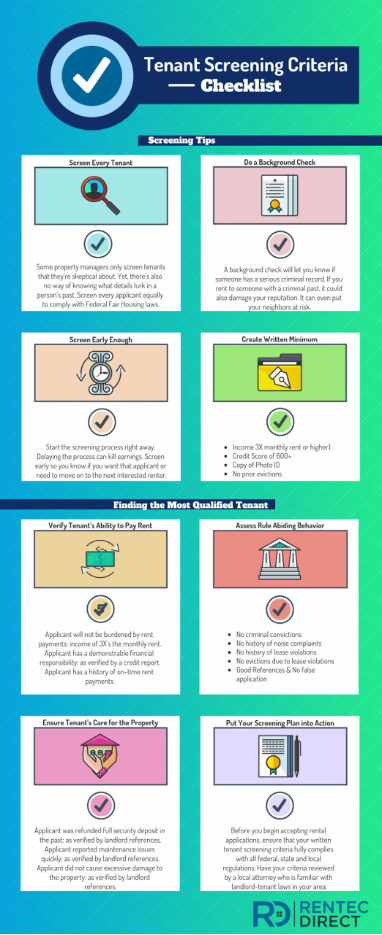
Title: Tenant Screening Criteria Checklist Infographic
Source: Rentec Direct
B. Clear and Comprehensive Lease Agreements
Develop a detailed lease agreement: Ensure your lease agreement clearly outlines the terms and conditions, including rent, security deposit, lease duration, and tenant responsibilities.
Communicate your expectations: Clearly explain your expectations for property maintenance, noise levels, and other important aspects of tenancy.
Include legal provisions: Incorporate clauses that protect you as the landlord, such as early termination fees, late payment penalties, and a process for handling disputes.
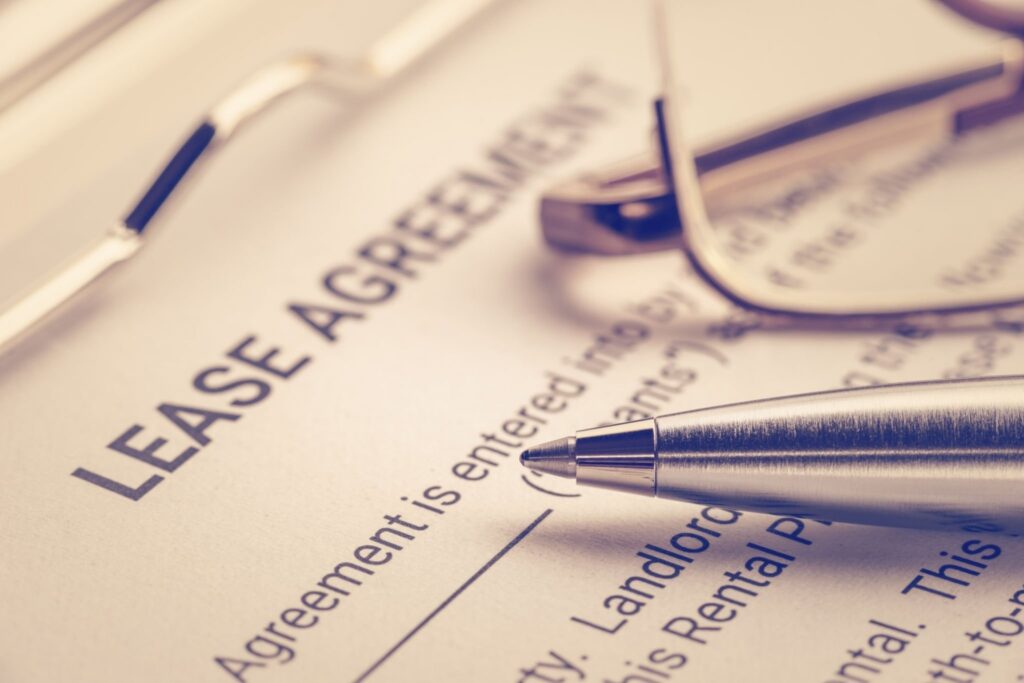
Figure: Business Legal Document Concept: Pen and Glasses on a Lease Agreement Form
Source: iStock by Getty Images
C. Effective Communication and Relationship Building
Maintain open lines of communication: Encourage tenants to reach out with concerns or issues and respond promptly and professionally.
Foster a sense of community: Organize events or activities that bring tenants together and create a positive living environment.
Show appreciation: Acknowledge tenants who pay rent on time, maintain the property, and follow the rules with small gestures, such as thank-you notes or occasional gifts.
D. Regular Property Inspections and Maintenance
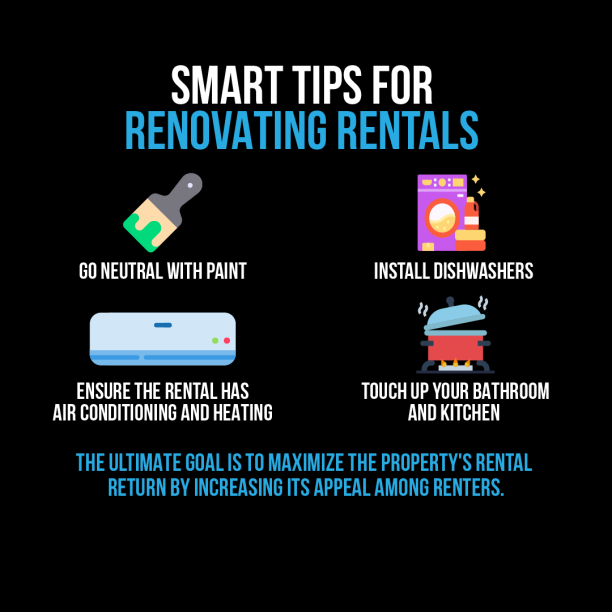
Figure: This infographic provides “Smart Tips for Renovating Rentals,” focusing on maximizing the property’s rental return by enhancing its appeal to renters. Key suggestions include going neutral with paint colors, installing dishwashers, ensuring the rental has air conditioning and heating, and touching up the bathroom and kitchen. These renovations are aimed at increasing the property’s attractiveness and functionality, making it more appealing to potential tenants and thereby boosting its rental value.
Source: Custom Infographic
Conduct routine inspections: Regularly inspect the property to identify potential issues and ensure tenants are complying with lease terms.
Address maintenance issues promptly: Respond to repair requests quickly and efficiently to maintain tenant satisfaction and protect your property’s value.
Keep a maintenance log: Document all repairs and maintenance activities to track expenses and demonstrate your commitment to maintaining the property.
E. Handling Tenant Issues and Conflicts
Be proactive: Address potential problems early to avoid escalation and minimize the impact on other tenants.
Practice empathy and active listening: Understand your tenant’s perspective and work together to find a mutually beneficial solution.
Follow the law: Always adhere to local landlord-tenant laws when resolving disputes and dealing with tenant issues.
F. Evictions and End of Tenancy
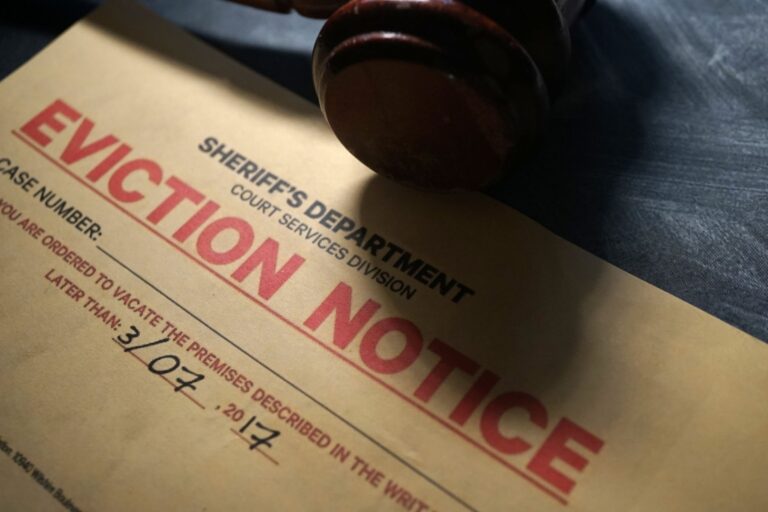
Figure: A visual representation capturing the concept of an eviction notice, emphasizing the gravity and implications of such a notice in the real estate sector.
Source: iStock
Know the legal process: Familiarize yourself with the eviction laws in your jurisdiction and ensure you follow the correct procedures.
Provide proper notice: Give tenants ample notice before initiating eviction proceedings, as required by law.
Document the process: Maintain detailed records of all communications, notices, and legal actions related to the eviction process.
In conclusion, adopting these best practices for dealing with tenants can help you create a positive environment, reduce losses, and minimize bad interactions. By effectively screening tenants, establishing clear lease agreements, maintaining open communication, conducting regular property inspections, handling issues proactively, and following the law, you can ensure a successful real estate investment experience.
Key Takeaways:
Closing Statement: The journey of a real estate investor is one of continuous learning, adaptation, and cultivation of best practices. Tenant relations sit at the heart of this experience. By emphasizing thorough screenings, transparent agreements, open communication, and proactive issue resolution, landlords can foster an atmosphere of trust and cooperation. This foundation aids not only in mitigating risks but also in amplifying investment success.
- Tenant Screening: It is pivotal to validate a tenant’s financial stability, identity, employment, and past rental behavior. A systematic and unbiased screening process can safeguard against potential future hiccups.
- Lease Agreements: A comprehensive lease agreement acts as a safety net for both parties. Clarity in terms, tenant responsibilities, and landlord expectations is crucial for maintaining harmonious relations.
- Communication: Open, respectful, and timely communication can resolve most disputes and misunderstandings. Celebrating tenant achievements or community events can further enhance this relationship.
- Property Maintenance: A well-maintained property retains its value and ensures tenant contentment. Periodic inspections can preemptively address potential issues, preserving both the property’s value and the tenant’s satisfaction.
- Conflict Resolution: Conflicts are inevitable, but how they are handled can define the landlord-tenant relationship. Empathy, active listening, and adherence to laws ensure a fair resolution.
- Evictions: When all else fails, eviction might become necessary. However, it’s paramount to know and strictly adhere to legal procedures, provide proper notice, and document each step meticulously.

